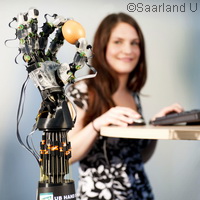Robotic arm with tact and finesse, the EU way
Europeans are strong innovators, and the latest example of their hard work is a robotic hand able to hold and grasp bottles and cups. The novel 'helping hand' is an outcome of the DEXMART ('Dexterous and autonomous dual-arm/hand robotic manipulation with smart sensory-motor skills: a bridge from natural to artificial cognition') project, which was backed with EUR 6.3 million under the 'Information and communication technologies' (ICT) Theme of the EU's Seventh Framework Programme (FP7). Scientists from Germany, France, Italy and the United Kingdom created the robotic hand that is just slighter bigger than a human arm by using a string actuator, a type of motor used to move or control a mechanism or system. In this particular case, small electric motors were used to twist strings. 'We wanted to impart our robotic hand with a broad spectrum of human traits,' says Chris May, an undergraduate student from the Laboratory of Actuation Technology at the University of Saarland in Germany. 'Its artificial muscles should be able to deliver enormous forces by simple and compact means.' 'When robots help around the house or should save people from a burning building, they need to have hands which can grasp with strength but at the same time gently,' says Hartmut Janocha, a professor of Process Automation at Saarland University. What the researchers have to do is develop the technology needed to make the robotic arm as close as possible to that of the human arm, both in terms of size and form. 'We came up with a simple, yet extremely effective idea: using strings that are twisted by small, high-speed motors, we are able to exert high tensile forces within a compact space,' explains Mr May. 'The sensorised and controlled robotic hand is able to touch diverse objects, to grasp and lift them and place them gently in a new position,' he adds. 'Each robotic finger, which like a human finger [comprises] three segments, can be controlled precisely by means of the individual tendons. The capability of the robotic hand is so near to that of humans that the vision of robots as personal assistants in the household, in the operating room as well as in industrial settings is becoming ever more realistic. We presume that the combination of small electric motors with twisted string is interesting for other applications as well.' Overall, researchers believe that robots can play as much a significant role in people's homes as they do in manufacturing plants. Handling objects with more finesse and ensuring safety with humans will definitely make the difference.For more information, please visit:University of Saarland:http://www.uni-saarland.de/en/home.htmlDEXMART:http://www.dexmart.eu/
Countries
Germany



